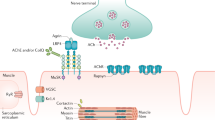Summary
A myasthenia gravis (MG) patient who seems to have recovered can later have recurrence of myasthenic signs. Clearly clinical remission does not always correspond to the normalization of all the factors involved in the pathogenesis of the disease. In ten patients who had apparently recovered from MG, electromyographic tests of repetitive supramaximal stimulation were performed and the anti-acetylcholine receptor (anti-AChR) antibody was assessed. In two of the ten patients all these tests were normal, thus showing lack of electromyographic myasthenic fatigability and the absence of circulating anti-AChR antibodies. Our hypothesis is that for these two subjects the risk of a recurrence of MG is lower than for the others.
Zusammenfassung
Ein Patient mit Myasthenia gravis kann auch dann, wenn er sich anscheinend von der Erkrankung vollständig erholt hat, Rückfälle aufweisen. Es ist offensichtlich, daß eine klinische Remission durchaus nicht mit der Normalisierung aller beim Krankheitsprozeß mitwirkenden pathogenetischen Faktoren identisch ist. Bei 10 Patienten, die klinisch scheinbar geheilt waren, wurden elektromyographische Untersuchungen mit repetitiver supramaximaler Reizung ausgeführt sowie die Antiacethylcholinrezeptorenantikörper bestimmt. Zwei der 10 Patienten wiesen normale elektromyographische Befunde und das Fehlen zirkulierender Antiacethylcholinrezeptorenantikörper auf. Die Autoren formulieren die Annahme, daß für diese zwei Individuen das Rückfallrisiko niedriger als bei den anderen ist.
Similar content being viewed by others
References
Bartoccioni E, Scuderi F, Scoppetta C, Evoli A, Tonali P, Guidi L, Bartoloni C, Terranova T (1980) Myasthenia gravis, thymectomy, and antiacetylcholine receptor antibody. J Neurol 224:9–15
Bramis J, Papatestas AE, Sloane C, Genkins G, Aufses AH, Jr (1977) Effects of thymectomy in human oncogenesis. J Surg Res 22:305–312
Buckingham JM, Howard FM, Jr, Bernatz PE, Payne WS, Harrison EG, Jr, O'Brien PC, Weiland LH (1976) The value of thymectomy in myasthenia gravis: a computer-assisted matched study. Ann Surg 184:453–457
Desmedt JE (1958) Méthodes d'étude de la fonction neuromusculaire chez l'homme. Acta Neurol Belg 52:977–1017
Edwards FR, Wilson A (1972) Thymectomy for myasthenia gravis. Thorax 27:513–516
Genkins G, Papatestas AE, Horowitz SH, Kornfeld P (1975) Studies in myasthenia gravis: early thymectomy. Am J Med 58:517–524
Horowitz SH, Genkins G, Kornfeld P, Papatestas AE (1975) Regional curare test in evaluation of ocular myasthenia. Arch Neurol 32:84–88
Lefvert AK, Bergstrom K, Matell G, Ostermann PO, Pirskanen R (1978) Determination of acetylcholine receptor antibody in myasthenia gravis: clinical usefulness and pathogenetic implications. J Neurol Neurosurg Psychiatry 41:394–403
Ozdemir C, Young RR (1976) The results to be expected from electrical testing in the diagnosis of myasthenia gravis. Ann NY Acad Sci 274:203–222
Papatestas AE, Alpert LI, Osserman KE, Osserman RS, Kark AE (1971) Studies in myasthenia gravis: effects of thymectomy. Am J Med 50:465–474
Piantelli M, Lauriola L, Carbone A, Evoli A, Tonali P, Musiani P (1979) Subpopulations of T-lymphocytes in myasthenia gravis patients. Clin Exp Immunol 36:85–89
Sandilands GP, Gray K, Cooney A, Anderson JR, Simpson JA, Behan PO (1975) Rosette tests following thymectomy. Lancet 1:171–172
Scadding GK, Webster ADB, Ross M, Thomas HC, Harvard CWH (1979) Humoral immunity before and after thymectomy in myasthenia gravis. Neurology (Minneap) 29:502–506
Scoppetta C, Tonali P, Lo Monaco M, Vaccario ML (1978) Tests elettrofisiologici nella miastenia. Riv Ital EEG Neurofisiol 1:117–122
Scoppetta C, Tonali P, Evoli A, David P, Crucitti F, Vaccario ML (1979) Treatment of myasthenia gravis. J Neurol 222:11–21
Scoppetta C, Burrai I, Tonali P, Russo L (1979) Myasthenia gravis, thymectomy and T-cells. Neurology (Minneap) 29:419
Scoppetta C, Tonali P, David P, Lo Monaco M, Palieri G (1979) Repetitive supramaximal stimulations and regional curare test in diagnosis of myasthenia gravis. Acta Neurol Scand [Suppl 73] 60:207
Seybold ME, Lindstrom JM (1981) Myasthenia gravis in infancy. Neurology (NY) 31:476–479
Simpson JA, Behan PO, Dick HM (1976) Study of the nature of autoimmunity in myasthenia gravis. Evidence for an immunodeficiency type. Ann NY Acad Sci 274:382–389
Author information
Authors and Affiliations
Rights and permissions
About this article
Cite this article
Scoppetta, C., Bartoccioni, E., David, P. et al. When is there a full recovery for a myasthenia gravis patient?. J Neurol 227, 61–65 (1982). https://doi.org/10.1007/BF00313771
Received:
Issue Date:
DOI: https://doi.org/10.1007/BF00313771




